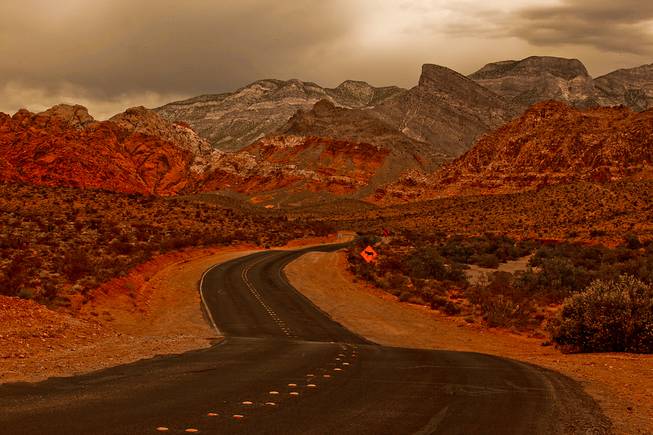
Ominous clouds roll into Red Rock Canyon National Conservation Area on West Calico Basin Road on Sunday, July 3, 2011.
Thursday, July 21, 2011 | 5:05 p.m.
Sun Coverage
One of Southern Nevada’s traffic problem spots isn’t on a freeway, or even in the Las Vegas Valley. It’s out at Red Rock Canyon National Conservation Area.
Traffic problems there aren’t a daily occurrence, but they happen frequently enough in the busy seasons that officials are bringing in national experts to try to solve the problems.
The area, and especially the 13-mile scenic drive, seems to be suffering from its popularity.
The parking areas, especially along the first few miles of the scenic drive, can get crowded, creating a traffic backup on the road. It mostly happens during the spring and fall, the area’s busiest seasons, and is especially bad on the day after Thanksgiving.
“When we have a big backup out here it’s something we hear about a lot from the public,” said Robbie McAboy, the area’s manager.
The Bureau of Land Management, which oversees the area, held an open house Thursday afternoon on the subject. The bureau has hired the Volpe National Transportation Systems Center, which is part of the U.S. Department of Transportation, to study the issue and come up with solution ideas.
The $430,000 study is being paid for with money from the Southern Nevada Public Land Management Act and a grant from the Federal Transit Administration.
“It’s a lot of money, but it’s a lot of money to address a very serious concern we have along the scenic drive,” McAboy said.
The transportation feasibility study, which should be done in March 2013, will study the problem and find potential solutions, then perform an environmental assessment of the alternative solutions and then create an implementation plan.
The possible solution that has been used in other areas, but also seemed the least popular among those who attended the open house, is to require visitors to use mass transit of some sort rather than drive their own vehicles on the scenic drive.
“We want to provide access, we want to have minimal impact on the land, that often means alternative transportation,” said Aaron Jette, a Volpe technical analyst.
But that doesn’t mean they’ve already decided to use a transit setup, he said. “This is a transportation feasibility study, not a transit feasibility study.”
Haley Peckett, the project manager for the transportation center, said they would look at all the possible solutions and are starting with just getting to know the area and then will work with stakeholders to find possible solutions.
“We’re not coming with a bunch of alternatives laid out, we’re coming to understand the problem and get ideas,” she said.
One of the other problems the study will have to address is finding possible funding sources for the changes needed.
As the process progresses, the transportation center and the BLM will hold more official public meeting on the study and the proposed solutions.

Join the Discussion:
Check this out for a full explanation of our conversion to the LiveFyre commenting system and instructions on how to sign up for an account.
Full comments policy